Edward Onslow Ford (1852-1901)
Edward Onslow Ford's Works
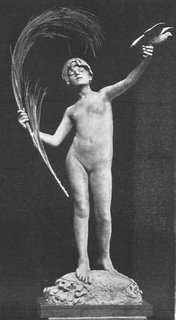

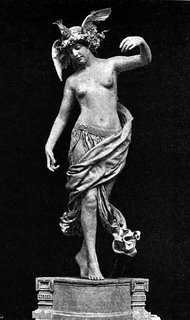
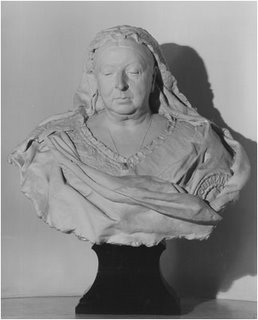
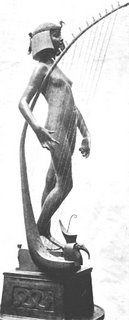

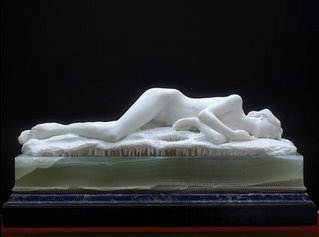
The sculptor Edward Onslow Ford (1852-1901) was born in Islington, North London, and initially studied painting on the Continent, where he worked under Buffeau in Antwerp, and with E. R. Mullins in Munich. On his return to London in 1874, he decided to become a portrait sculptor. He fell under the influence of Alfred Gilbert, and became one of the central figures of the New Sculpture Movement. His work, then, includes a mix of portrait sculptures and ideal works including many allegorical nudes.
These very different strands in Onslow Ford's work almost seem by separate hands. His portrait sculpture tends to the highly finished, and he shows a liking for complex folded drapery, in a way that looks as if the sitter 'just happened to sit like that'. This uncompromisingly realist work is in contrast to the studied softness and ideal unblemished youthfulness of his allegorical nudes, especially those in marble. These latter works have the inspiration of Gilbert written all over them, and put Ford squarely in the symbolist camp. Like Gilbert, in his Symbolist pieces, Ford was not averse to the use of different coloured metals and jewels to give an exotic polychromatic effect.
Ford's The Singer (1889) was one of only two sculptural works among Henry Tate's original gift to the nation. Also in the Tate Gallery is Folly (1886), which was bought through the Chantrey Bequest and also exists in versions in the Ashmolean Museum and at Port Sunlight. Other work at Port Sunlight includes the marble Snowdrift. Peace is (1887) in the Walker Art Gallery in Liverpool (small copies elsewhere, e.g. Leicester), and Fate (1902, completed posthumously by his son) exists in versions at the V and A and Port Sunlight. Busts of Millais and the actor Henry Irving are at the National Portrait Gallery. Also in London, a bust of General Gordon (1892), and Ruskin of 1900, both in Westminster Abbey. His exterior sculpture includes the Victoria Monument (1901) in Manchester and, in London, the busts for the facade of the Royal Society of Painters in Watercolours building in Piccadilly (1881/2).
I have coppied this directly from the excellent website of Bob Speel http://myweb.tiscali.co.uk/speel/index.htm who is doing a great job for English sculpture of the Victorian era. I recommend you visit his site.
Snow Drift was found at:
http://www.liverpoolmuseums.org.uk/ladylever/collections/snowdrift.asp







The sculptor Edward Onslow Ford (1852-1901) was born in Islington, North London, and initially studied painting on the Continent, where he worked under Buffeau in Antwerp, and with E. R. Mullins in Munich. On his return to London in 1874, he decided to become a portrait sculptor. He fell under the influence of Alfred Gilbert, and became one of the central figures of the New Sculpture Movement. His work, then, includes a mix of portrait sculptures and ideal works including many allegorical nudes.
These very different strands in Onslow Ford's work almost seem by separate hands. His portrait sculpture tends to the highly finished, and he shows a liking for complex folded drapery, in a way that looks as if the sitter 'just happened to sit like that'. This uncompromisingly realist work is in contrast to the studied softness and ideal unblemished youthfulness of his allegorical nudes, especially those in marble. These latter works have the inspiration of Gilbert written all over them, and put Ford squarely in the symbolist camp. Like Gilbert, in his Symbolist pieces, Ford was not averse to the use of different coloured metals and jewels to give an exotic polychromatic effect.
Ford's The Singer (1889) was one of only two sculptural works among Henry Tate's original gift to the nation. Also in the Tate Gallery is Folly (1886), which was bought through the Chantrey Bequest and also exists in versions in the Ashmolean Museum and at Port Sunlight. Other work at Port Sunlight includes the marble Snowdrift. Peace is (1887) in the Walker Art Gallery in Liverpool (small copies elsewhere, e.g. Leicester), and Fate (1902, completed posthumously by his son) exists in versions at the V and A and Port Sunlight. Busts of Millais and the actor Henry Irving are at the National Portrait Gallery. Also in London, a bust of General Gordon (1892), and Ruskin of 1900, both in Westminster Abbey. His exterior sculpture includes the Victoria Monument (1901) in Manchester and, in London, the busts for the facade of the Royal Society of Painters in Watercolours building in Piccadilly (1881/2).
I have coppied this directly from the excellent website of Bob Speel http://myweb.tiscali.co.uk/speel/index.htm who is doing a great job for English sculpture of the Victorian era. I recommend you visit his site.
Snow Drift was found at:
http://www.liverpoolmuseums.org.uk/ladylever/collections/snowdrift.asp
